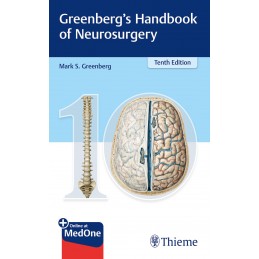- Obniżka


 Dostawa
Dostawa
Wybierz Paczkomat Inpost, Orlen Paczkę, DHL, DPD, Pocztę, email (dla ebooków). Kliknij po więcej
 Płatność
Płatność
Zapłać szybkim przelewem, kartą płatniczą lub za pobraniem. Kliknij po więcej szczegółów
 Zwroty
Zwroty
Jeżeli jesteś konsumentem możesz zwrócić towar w ciągu 14 dni*. Kliknij po więcej szczegółów
The fundamental, one-stop global resource for neurosurgical practice in updated 10th edition
Unlike traditional medical textbooks, the origins of the now legendary Handbook of Neurosurgery by Mark Greenberg took root in the late 1980s in the notes the author kept while taking care of his patients, from his weekly grand rounds presentations, and in the literature he read. Now in its 10th edition, the book that is often referred to as the bible for neurosurgeons has grown organically over the years to include more topics of importance to those who provide healthcare to patients with neurologic ailments, and to reflect advances in the understanding and management of the underlying conditions and diseases.
Throughout 23 sections and 116 chapters, the generously illustrated text covers information ranging from pediatrics to geriatrics. The comprehensive, conveniently compact book provides detailed, high-value, and actionable information that can be quickly accessed to enhance patient management, thereby eliminating the need to wade through superfluous material. It is also a perfect study companion for board examination and preparation for the maintenance of certification.
Key Features::
This unique book encompasses a wide breadth of neurosurgical topics in an easy digestible format, making it an indispensable daily reference for all neurosurgical residents, fellows, neurosurgeons, and allied health practitioners.
This print book includes complimentary access to a digital copy on https://medone.thieme.com.
Publishers Note:: Products purchased from Third Party sellers are not guaranteed by the publisher for quality, authenticity, or access to any online entitlements included with the product.
Opis
Indeks: 19057
Autor: Jeffrey P. Okeson
Indeks: 15644
Autor: Piotr Pruszczyk
